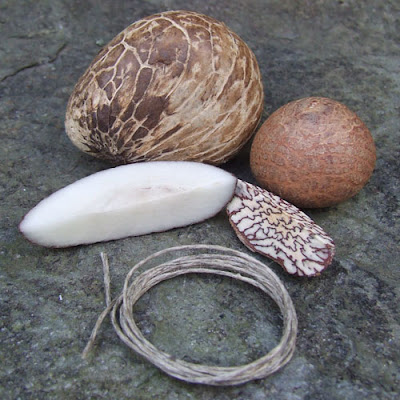Working with tagua nuts is fairly new to me, although I have been aware of their existance for some time now. Tagua palms are known by several names and grow in South America from southern Panama along the Andes to Ecuador, Bolivia and Peru, with Brazil's native species dominating international trade.
The large nut on the left of the image below is the whole tagua nut with a thin slice showing its hard white interior in front.
The use of these nuts stimulates local economies in South America and is said to be a substitute for the use of ivory as it has similar texture and appearance. It is for this reason that tagua nuts are commonly referred to as vegetable ivory.
The smaller nut to the right in the image above is a betel nut. Although it is commonly referred to as a betel nut, it is in fact the seed of the areca palm, which grows in much of the tropical pacific. After the seed has dried into a wood-like consistency, it reveals a beautiful pattern as shown in the small slice.
This nut is usually sliced thinly and wrapped in a betel leaf (hence its erroneous nickname) along with other spices to be chewed as a mild stimulant.
These are my first attempts at using tagua for creating pendants and as you can see, I have inlayed betel nut into the thin slices of tagua to illustrate the contrast of the betel nut's pattern to the plain ivory white of the tagua. The pendant in the centre has been backed with buffalo leather that has been stitched into place and then adorned with a single red sandalwood seed That I sourced in Western Australia many years ago.
All of the cordage has been crafted from a European grown/produced hemp thread that I coated in beeswax prior to twisting. The image above shows the completed pendant and 6 ply cord. The toggle has been crafted from a single seed from a rather large seed pod of the Royal Poinciana tree, also sourced from Western Australia.



